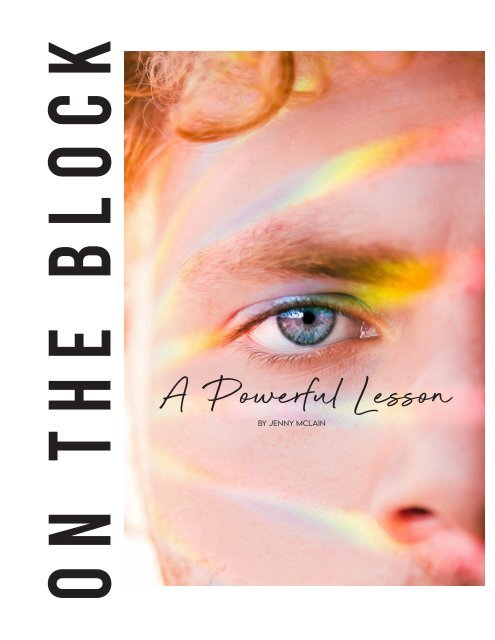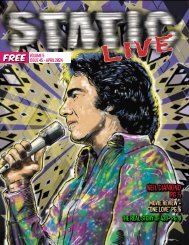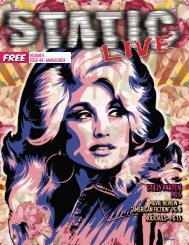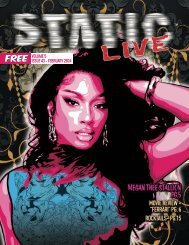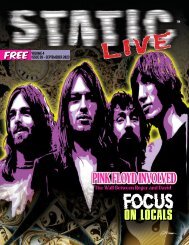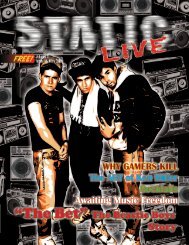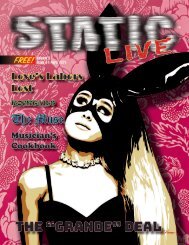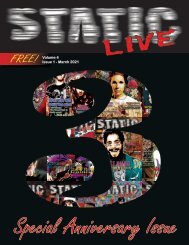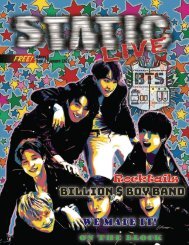Static Live Magazine July 2020
STATIC LIVE Magazine is Central Florida’s premier publication dedicated to celebrating music and culture. STATIC LIVE provides extensive, detailed community information from fashion to art, entertainment to events through noteworthy interviews, sensational photography and in-depth editorial coverage. STATIC LIVE is the only publication of its kind in Central Florida and reaches all target markets through wide distribution channels. Our staff includes highly accomplished contributors with award-winning backgrounds in music and entertainment; we know how much business is captured from the entertainment market. Our free full color publication can be found throughout Central Florida at key retailers, hotels and restaurants in high traffic areas. Our mission is to highlight the incredible talent, culture and lifestyle in Central Florida. With eye-opening profiles and coverage of the music and art community, STATIC LIVE readers will be positively influenced by our topical content and trending advertisers. STATIC LIVE Magazine is the most effective tool for branding connectivity with consumers in our area.
STATIC LIVE Magazine is Central Florida’s premier publication dedicated to celebrating music and culture. STATIC LIVE provides extensive, detailed community information from fashion to art, entertainment to events through noteworthy interviews, sensational photography and in-depth editorial coverage. STATIC LIVE is the only publication of its kind in Central Florida and reaches all target markets through wide distribution channels. Our staff includes highly accomplished contributors with award-winning backgrounds in music and entertainment; we know how much business is captured from the entertainment market. Our free full color publication can be found throughout Central Florida at key retailers, hotels and restaurants in high traffic areas. Our mission is to highlight the incredible talent, culture and lifestyle in Central Florida. With eye-opening profiles and coverage of the music and art community, STATIC LIVE readers will be positively influenced by our topical content and trending advertisers. STATIC LIVE Magazine is the most effective tool for branding connectivity with consumers in our area.
You also want an ePaper? Increase the reach of your titles
YUMPU automatically turns print PDFs into web optimized ePapers that Google loves.
ON THE BLOCK<br />
A Powerful Lesson<br />
By Jenny McLain<br />
On April 5, 1968 American school teacher Jane Elliott first<br />
conducted her now famous “Brown Eyes/Blue Eyes” exercise for her<br />
third grade class. It was the day after Martin Luther King Jr. was<br />
assassinated. She decided after watching the madness that it was<br />
time to try the eye color exercise she had thought about many times<br />
but had not introduced to her students. She created a microcosm<br />
of society in a third grade classroom. The local Iowa newspaper<br />
published the compositions the students had written about the<br />
experience and it put Ms. Elliott on the path of becoming a public<br />
speaker as an antiracism activist.<br />
The third time she held the classroom exercise with her third graders<br />
in 1970, it was filmed and became the documentary “The Eye of the<br />
Storm”. This also inspired a retrospective fifteen years later called “A<br />
Class Divided” on an episode of the PBS series Frontline, revisiting<br />
the students at their High School Reunion. She has conducted the<br />
exercise with college students, which is the subject of the 2001<br />
documentary “The Angry Eye”. In the episode of Frontline, she<br />
conducted the exercise with a group of employees from the Iowa<br />
Department of Corrections, which includes the “debriefing” of the<br />
group at the end of the exercise.<br />
If you are not familiar with it, Jane Elliott taught at a school in<br />
Riceville, Iowa, a town with an exclusively white Christian population.<br />
It must have been difficult for the people there, and especially the<br />
school children, to understand what was going on in other parts<br />
of the United States. She began the day by talking about what<br />
kinds of people are treated differently and why, and she asked<br />
the students if they could understand how it would feel if they were<br />
treated differently based on the color of their skin. They quickly<br />
said they could, but she wanted them to FEEL it. Then she asked<br />
them what was different about them individually that might be used<br />
to separate them into groups. They split the class according to eye<br />
color. Since she, the teacher, has blue eyes, she decided that the<br />
blue eyed people would be on the top first.<br />
The kids with brown eyes were given collars by the kids with blue<br />
eyes so they could be easily identified from a distance and the class<br />
was told that blue eyed people were smarter, cleaner, and more<br />
civilized than brown eyed people. They were given examples of bad<br />
things that people who happened to have brown eyes had done<br />
and good things that were done by people with blue eyes and she<br />
made the argument that they behaved a certain way because of the<br />
color of their eyes. For that day, the blue eyed people would have<br />
5 extra minutes of recess; the brown eyed people could not use the<br />
drinking fountain and had to use paper cups. The blue eyed people<br />
could not play with the brown eyed people at recess, because the<br />
brown eyed people were not as good. The blue eyed people sat at<br />
the front of the room. The kids started owning the situation, treating<br />
their classmates differently, coming up with punishments if the brown<br />
eyed people got out of hand. Ms. Elliott says in the documentary<br />
that the transformation happened within 15 minutes of beginning the<br />
exercise. She called them “ghastly”.<br />
The tables were turned the next day and the brown eyed people<br />
were on top. She again gave examples of bad things done by blue<br />
eyed people and good things done by brown eyed people. The<br />
collars were switched and the same privileges given to the blue<br />
eyed people the day before were given to the brown eyed people.<br />
The expressions on the faces of the children is agonizing; you can<br />
see the frustration of feeling helpless when judged by the color<br />
of their eyes by kids who were their friends the day before and<br />
the euphoria of being considered superior. The kids who wore the<br />
collars did worse during lessons but did better when not wearing<br />
collars, simply because they were treated a certain way.<br />
After the two day exercise, Ms. Elliott talks to the students about<br />
how they felt while wearing the collars. One boy said he felt like a<br />
dog on a leash and another said it was like he had been locked<br />
in a prison. There is a powerful image of one of the blue eyed<br />
kids taking his collar off and tearing at it with his hands and teeth.<br />
In the end, they came together again as a class, with their arms<br />
around each other because they were released from the idea that<br />
they were better or worse based on the color of their eyes, each<br />
understanding the feeling of being judged unfairly. During the<br />
retrospective, they said they continue to feel a certain bond with<br />
each other because of the lessons they learned over those two<br />
days, fifteen years earlier.<br />
Also during the Frontline retrospective, the employees from the Iowa<br />
Department of Corrections talked about the frustration of being<br />
labeled inferior. When asked why they let a few of the people<br />
wearing collars stand up for themselves alone instead of joining<br />
forces they said that if the attention was on those few, it would be<br />
away from them. If those few had been successful, they would have<br />
joined them in the protest, but they felt that resistance was pointless.<br />
I first became aware of the exercise when I was working at Procter<br />
& Gamble, a company that was very focused on teambuilding. My<br />
job was to travel to various locations and conduct training classes<br />
for sales reps who were being issued laptop computers. I had<br />
worked as a district secretary before joining the IT department so<br />
I was familiar with their jobs as sales reps. Most of them were<br />
older and more experienced than me, except that they had never<br />
used a laptop. For the most part, they didn’t want the change that<br />
was being forced on them and they especially didn’t want a young<br />
woman who looked even younger than she was to be a symbol of<br />
the change. But, because of the teambuilding efforts of the company,<br />
we understood our roles and I can honestly say that I always felt<br />
respected, even if not always appreciated. And I was fine with that.<br />
I didn’t understand at the time what an impact it would have on my<br />
life. It gave me confidence in myself, my knowledge, and my abilities.<br />
Imagine how different the world would be if every third grader<br />
were taught this lesson, however harsh. Now lament the fact that<br />
no school today would be allowed to teach it.


